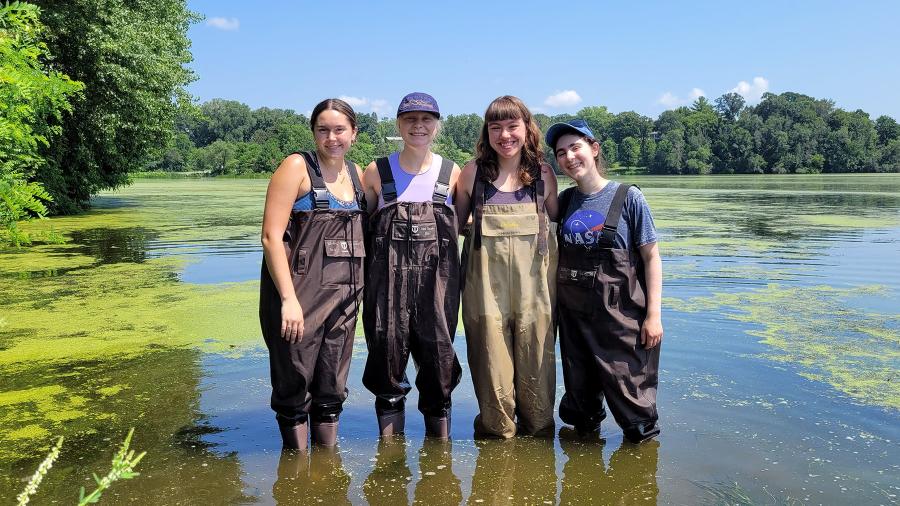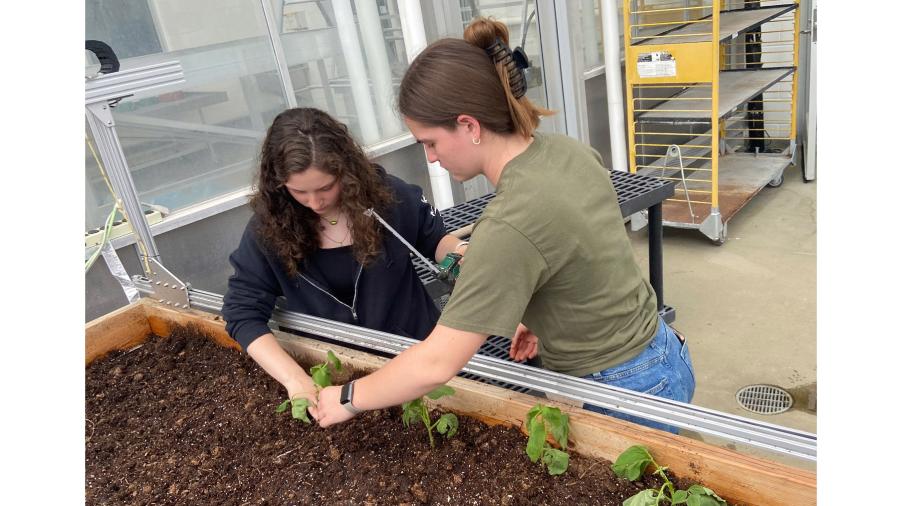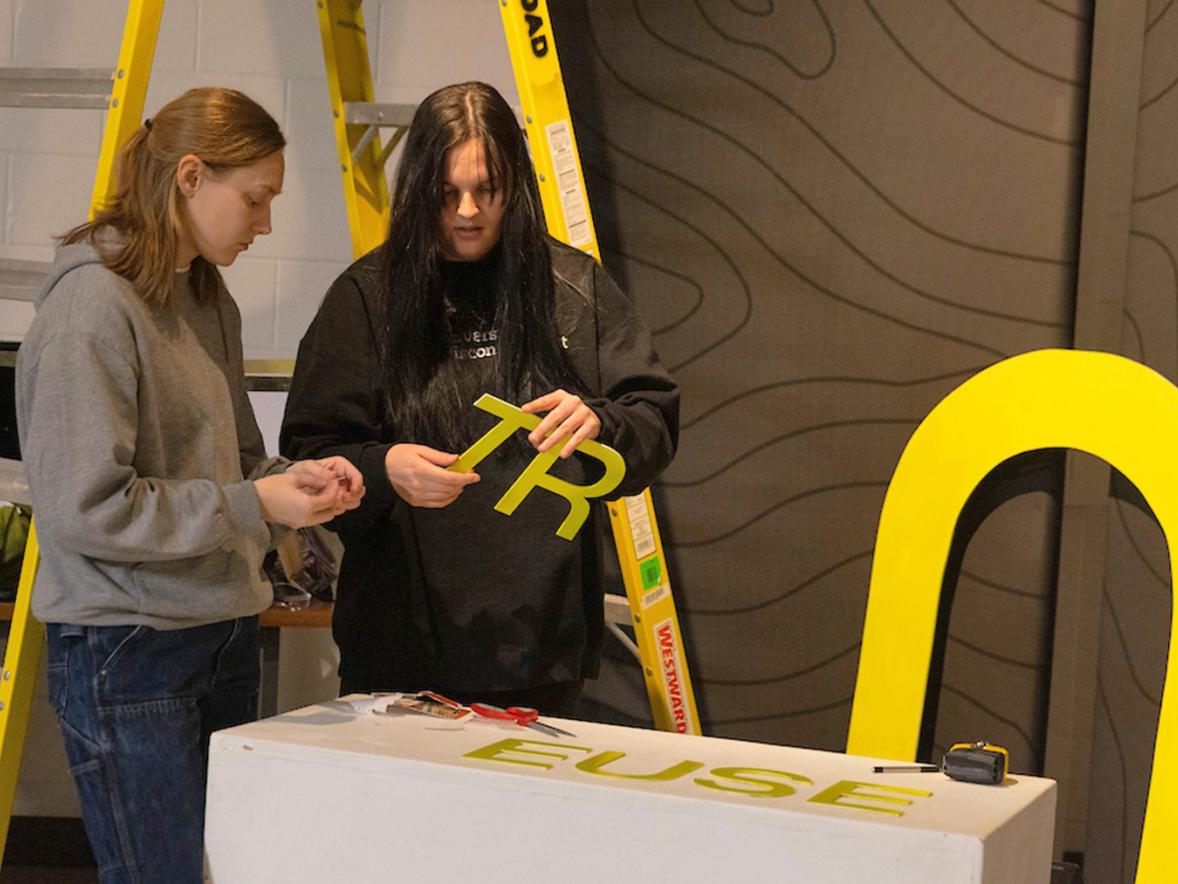Undergraduate researchers from across the U.S. and Canada have spent the summer in the Chippewa Valley investigating water quality awareness, invasive species, groundwater pollutants, public opinion and local mitigation for positive change in the Red Cedar watershed.
Led by UW-Stout co-directors Professor Tina Lee and Senior Lecturer Arthur Kneeland, LAKES REU students from eight universities are collaborating on research to improve the health of the watershed and develop sustainable solutions with community and government partners, local citizens and policymakers.
The interdisciplinary team of students represents a range of academic fields: anthropology, biology, environmental science, political science, mechanical engineering, and applied mathematics and computer science.
Students and mentors will present their findings from 5 to 8 p.m. on Thursday, Aug. 8, at the Raw Deal, 603 S. Broadway St., Menomonie. Community members are encouraged to join them in conversations about the local environment and issues facing the watershed.
Their research will be shared with local policymakers through reports, conversations and participation in the Red Cedar Water Quality Partnership in hopes of facilitating positive change in land use and water quality regulations and practices.
LAKES 2024 researchers
In addition to Lee and Kneeland, LAKES mentors include Professor Devin Berg, Assistant Professor Nicole Hayes and Professor Kim Zagorski.
“LAKES gives students the experience of being able to focus on research for a whole summer and to really immerse themselves in the problems they are working on. They get to work with and get to know community members and work on a problem that is important to the community,” Lee said.
Lee believes it’s important to consider the issues of water quality and pollution from various angles, from the biology of pollutants to human interactions with waterways.
“To address the dynamics of water quality issues in the Red Cedar watershed, we need to understand the people who live and own land here in an empathic way,” she said. “Our research adds to our knowledge and helps inform those who are working to address water quality issues. It’s important to understand the economic, social and cultural constraints people face as well as the capacities they have to help address problems, and these topics are a key focus of our work.”
Students, their degrees, schools and mentors are:
- Murphy Boksanski: environmental science at University of San Francisco, Lee and Kneeland
- Eva Elbert: environment and gender, sexuality, feminist and social justice studies at McGill University, Montreal, Quebec, Lee
- Lara Erickson: environmental studies at Carleton College, Northfield, Minn., Zagorski
- Olivia Franklin: community sustainability at UW-Stevens Point, Zagorski
- Maya Hoffman: public health science at University of Maryland College Park, Hayes
- Jennifer Kahn: biology at UW-Stevens Point, Hayes
- Lucas Krueger: anthropology and history at Beloit College, Lee
- Jessica Qualich: mechanical engineering at UW-Stout, Berg
- Shayla Riley: public policy at Georgia State University, Atlanta, Zagorski
LAKES REU is in its ninth year at UW-Stout. It is funded by the National Science Foundation and by the Freshwater Collaborative of Wisconsin, which works to enhance its water-related academic programs.
Lindsey Redepenning, an applied mathematics and computer science student at UW-Stout, and Professor Keith Wojciechowski are collaborating with LAKES researchers. Their research is funded through a separate Freshwater Collaborative of Wisconsin grant.
“Environmental sustainability and water quality is such an important issue and one we can’t ignore. Mentoring students is the absolute best part of my job, and it’s a privilege to get to know such an amazing group of young people each summer,” Lee said.
Making a decade of research accessible
Boksanski thinks that a direct pairing of science and communication is uncommon for undergraduate research opportunities, which makes LAKES stand out from other programs.
He is collaborating with local organizations to post infographics in the community to best present nearly a decade of LAKES research collected by nearly 100 students.
He read 20 peer-reviewed papers on scientific communication and found that different forms of communication appeal to different audiences and that the most effective presentations are jargon-free with simple statistics and offer background on researchers to give them credibility.
“The process of synthesizing nearly a decade’s worth of data can be grueling. You cannot fit all the information into a few reports, so picking the most important information from each topic is the biggest challenge,” Boksanski said.
“But it is rewarding. To put everything together and share our research with our community is important and feels great.”
Social Science: Activism in the community
As an applied anthropologist, Lee feels strongly that she should apply her research skills to problems that affect the area “since I’ve made it my home and am raising my children here,” she said.
Her hope for Elbert and Krueger is that they build a strong grounding in interviewing and qualitative coding techniques and are more prepared to conduct research in their careers or graduate school.
Elbert’s project is connected to work Lee has been involved with in collaboration with Grassland 2.0. She is interviewing community members from a variety of sectors in the area to explore what a healthy rural community would look like to them, what changes they see that should be made and how the community might come together to make those changes.
Krueger will present on the history of environmental activism around the Red Cedar watershed. He is reviewing archival material and interviewing community members to highlight their efforts.
“From the Great Lakes to wild rice, to the success of Chicago and Minneapolis as river cities, water and Midwestern culture are nearly synonymous. By studying either, we learn more about both,” he said.
Krueger believes that changes in water are reflective of changes in culture, citing the reversal of the Chicago River by civil engineers in 1900 and the damming of the Red Cedar River in the 1880s to create a mill pond for the lumber industry, forming what is now Lake Menomin.
“By studying what people protected and how they did it, we can better appreciate the water and land around us,” he said.
Biology: surveys on wind patterns and zebra mussels
Hayes wants Hoffman’s and Kahn’s LAKES experience to be their first steps as independent researchers as they survey harmful aquatic plant and animal species on Lake Menomin.
“I want Maya and Jennifer to leave LAKES with a better understanding of the scope and magnitude of the impact humans have on lakes and of how much we still need to learn about lakes,” she said.

Kahn is surveying the zebra mussel population density and hopes to raise awareness of the invasive species. In one field experience, she led Hoffman, Erickson and Franklin on a search for the mollusks at Lakeside Boat Launch near the Menomonie Public Library.
The finding of zebra mussels in the lake is recent. The Wisconsin Department of Natural Resources discovered several hundreds of the mollusks last fall when removing docks from the lake before winter.
At Lakeside, Kahn turned over rock after rock and sifted through sediment. She identified several zebra mussels, as well as Chinese mystery snails, also an invasive species.
“There isn’t a way to get rid of zebra mussels once they arrive, but we can limit the spread. People need to be aware of the species’ presence to prevent accidental introductions to noninfested water bodies. They should inspect and remove any aquatic plants or animals from their boats, trailers and equipment before leaving a launch,” Kahn said.

Hoffman is determining the impact of wind patterns on cyanobacteria bloom sizes and distribution.
This research on the harmful algae formations is her first exposure to limnology – the study of freshwater bodies. She has conducted different forms of data collection in the field, trekking through streams and collecting lake water samples while boating across Menomin and Tainter lakes. She is also gaining hands-on laboratory skills, filtering water samples to find Microcystis toxin concentrations and nutrient makeups and measuring algae colonies under the microscope.
“Looking at wind as a factor with cyanobacteria blooms is especially important when considering a recent phenomenon called atmospheric stilling,” Hoffman said. “This phenomenon is a climate change-driven pattern in which surface-level winds have been decreasing across the globe. These decreasing wind levels have been linked to increased harmful blooms in various other lakes across the world. Finding a link between climate change-driven patterns and these harmful blooms is an important sign to put more focus into this pressing environmental issue.”
Political science: Connecting awareness and policy
LAKES offers Erickson, Franklin and Riley an intersection of political science and environmental studies.
Erickson is compiling and analyzing perceptions of nitrate contamination in private wells in Dunn County, which may impact residents’ health and well-being.
Franklin is researching urban and residential runoff, its effects on waterways, public opinion and local mitigation on runoff. She is also investigating attitudes regarding sustainability and public perception.
Riley is a nontraditional student who grew up in a neighborhood next to a paper mill. Over the years, she noticed that people from the area suffered from reproductive issues and various cancers, including herself. She began to wonder if there was a link between the two. The experience inspired her passion for environmental studies.
Her LAKES research involves understanding if there is a relationship between a household’s awareness of local water pollution, the source of their indoor water and its quality.
“Existing research shows a strong connection between awareness and policy,” Riley said. “I think gaining detailed knowledge about local water quality issues empowers residents to take informed actions, whether advocating for better practices, participating in local initiatives or implementing personal changes to improve their own water safety.
“LAKES has been instrumental in my development as a student and researcher. It perfectly aligns with my plans to engage with and advocate for communities like my hometown and Dunn County to understand what resources are needed to make the changes necessary to improve the quality of life.”
Mechanical engineering and mathematics: Advancing agricultural technology
Berg, Qualich, Wojciechowski and Redepenning are collaborating on research to advance agricultural technology, working in the Jarvis Hall Greenhouse Lab on campus and with Chippewa Valley Bean of Dunn County, the world’s largest producer of dark red kidney beans. Wojciechowski is a project consultant at Chippewa Valley Bean.

Qualich, of Buffalo Grove, Ill., is growing kidney beans using Farmbot, an automated three-axis robotic farming system housed in the greenhouse. Farmbot allows Qualich to study precision planting, watering and soil analysis techniques and climate simulations.
Redepenning, of Elk River, Minn., is using Farmbot to receive data input such as irrigation levels and to take photos of the kidney bean crop canopy cover twice weekly. The data and photos help her track growth through a canopy cover model, which displays leaf area, ground cover area, plant conditions and productivity.
Redepenning was drawn to UW-Stout's AMCS program because it offers “the perfect balance of math and computer science to give me a wealth of knowledge in both subjects.” She will graduate in December 2025 and plans to work in industry or earn her master’s degree.

Students’ 2024 research will be posted in August on the LAKES website, where past research is also available.
Students receive a $5,400 research stipend for the summer, as well as housing in UW-Stout’s residence halls, a $450 food allowance, up to $500 in travel reimbursement and funding support to travel to the National Conference on Undergraduate Research to present their final research findings.





